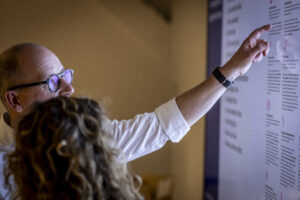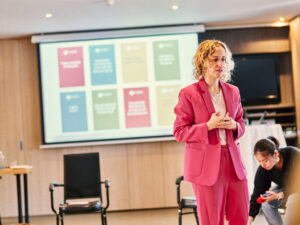Up until a few years ago, we mostly used ‘hybrid’ when discussing cars. Now, after a period of working remotely, we’re experiencing a shift to a hybrid way of working. Companies are treading in impatience to bring back their people to the office. While some employees feel the same need, others are more reluctant to give up their safe space at home. It’s up to the business leaders and HR managers to make the puzzle, with their employees’ personal needs, feelings, and preferences as the pieces.
To help and inspire, we’re sharing six trends we’ve noticed in the hybrid way of working – based on what we’re experiencing in the field and reading in our feeds.
1 – Hybrid sucks, the future is hybrid
This past year, we’ve all found our ways to tackle our daily work. For meetings, trainings, and workshops, however, hybrid simply sucks. When mixing people in the office and people dialing in, connection issues (both technical and relational) and miscommunication can lead to friction. Those at home feel left out because they miss half of what is being said, those in the office get frustrated because they have to repeat themselves every other second. Let alone those poor suckers who have to lead or facilitate these hybrid meetings.
“I can’t wait for this to be over so we can finally meet in person again”, you might think. Think again. Because whether we like it or not, our future way of working will most definitely be hybrid. Now that we have tasted the sweetness of remote work, there’s no going back. Organizations will have to face the challenge of figuring out how to get their teams to interact and collaborate in this hybrid setting.
Luckily, hybrid doesn’t have to suck. It all comes down to the how. How you go hybrid is not fixed in stone and depends on the needs of both your people and your organization. This will require a thorough redesign of your workplace, your work processes, and your workforce. But if you get it right, this hybrid way of working will lead to a more productive and purposeful way of working.
2 – When it comes to our teams, 1 + 1 no longer equals 3
According to multiple studies by Microsoft, one of the biggest and most worrisome changes in our nature of work is the impact that a year of full-time remote work has had on our organizational connections. By analyzing trillions of productivity signals (emails, meetings, chats, …) and conducting a survey with more than 30.000 people, they discovered that the shift to remote and hybrid work has significantly shrunk people’s networks.
Since the pandemic hit, our top priority was to make sure everyone had everything they needed to stay healthy & happy and to perform well on their own little island in the big sea of remote work. This increased focus on individual wellbeing has taken the attention away from the teams. We have lost the connections between those islands. The relationships and collaboration between team members. That feeling of belonging, of being part of one team with one shared goal.
In facilitating remote teams ourselves, we have noticed that for many organizations, the biggest pain is not the performance of individual team members, but a decreased sense of belonging resulting in less team performance. One of the biggest challenges leaders are facing today is how to create a context where team members stay connected and keep that sense of belonging.
3 – From a hybrid way of working to a hybrid way of learning
Organizations all over the world have given their employees more flexibility in where and when they work. At first simply because they had no other choice, but more and more they’ve been acknowledging the fact that it’s the right choice. Increased flexibility will not only benefit us in the way we do our work but also in the way we learn.
No more stuffed classrooms or event centers with people from all over the world getting the same training at the same time. In the hybrid way of working/learning, we’re making a shift to a blended approach of synchronous and asynchronous learning. Combining for example virtual group sessions with individual self-paced courses. This way, learning journeys can not only run independently of time and place but also cross borders to stimulate global development.
If you want to get an idea of what that blended learning looks like, check out the work we did for Etex. Together with an internal L&D Design Team, we created an impactful Leadership Development Program. And had a lot of fun delivering it!
4 – It’s easier to fall overboard in a hybrid workforce
Working remotely this past year, everyone was in the same boat. We all had to spend our days going from one virtual meeting to another, with some virtual drinks on Friday if we were lucky. In the hybrid way of working, it has become easier to fall overboard.
When operating in a hybrid setting, some team members will be physically present in the workplace while others will be working from somewhere else. Splitting the original team into ‘team office’ and ’team home’. According to Kathleen Vangronsvelt, professor in HRM & Organizational Behavior at the Antwerp Management School, this divide will lead to the formation of in- and out-groups. As ‘team office’ spends more time together physically, they will form the in-group and reinforce their identity as a group by highlighting their differences with the out-group, namely ‘team home’.
Add to this trend one, where hybrid meetings lead to friction and frustration, and trend two, where we lost connections between team members, it’s safe to say that the existence of in- and out-groups will have a significant impact on productivity and performance.
5 – Keeping ourselves safe actually hurts our psychological safety
Psychological safety— the belief that one can speak up without the risk of punishment or humiliation – is a key driver for team performance. Nothing new, right? Even though this concept by Amy Edmondson has been around for a while, organizations are still struggling to foster this culture of psychological safety.
In a hybrid way of working, this becomes even harder for two reasons. First of all, there’s a big difference between opening up to your manager in person and sharing your personal views and feelings with your computer screen. Psychological safety is about voicing concerns, admitting to failures, speaking up about difficult topics. This requires some level of trust and connectedness with the other person, a feeling many have lost in the past year.
Secondly, as mentioned before, HR and business managers now have to take into account personal circumstances when making the puzzle of hybrid work. Suddenly, it’s not just about work anymore. The lines between our private lives and our work lives have blurred. While speaking up and embracing friction and failure already required a lot of bravery before, having psychologically safe discussions around work-life balance issues is even more challenging.
6 – The new pieces of productivity
“Over the past year, no area has undergone more rapid transformation than the way we work. Employee expectations are changing, and we will need to define productivity much more broadly – inclusive of collaboration, learning, and wellbeing.” – Satya Nadella, CEO at Microsoft
Our sixth and final trend comes down to a summary of the five previous ones. A different way of working also requires a different way of looking at certain aspects of our organization, such as productivity. For years, we have learned that issues with productivity meant issues with processes. If you fix the process, you will fix the problem. But productivity is highly influenced by team collaboration, which in turn is impacted by underlying team dynamics such as cohesion, belonging, and psychological safety.
So when laying the puzzle of a productive hybrid workforce, HR and business leaders will not only have to take into account the needs of their employees on an individual level. It is equally, if not more, important to devote attention to a more vulnerable entity: the team.
Now how do you go hybrid?
As stated in the first trend, the way to go hybrid is not fixed in stone. It’s also not something you will be able to do overnight. Going hybrid requires a lot of thought and consideration, enabling a deep shift in behavior and organization culture. As an HR or business leader, you will have to design hybrid work arrangements with individual human concerns in mind, not just institutional ones.
If you’re looking for some inspiration, we recommend this article by Emma Braeye, VP People at In the Pocket, on their journey towards a hybrid way of working. Explaining how they are trying to find that sweet spot between keeping the company culture alive and giving enough freedom of choice to their teams.
If you’re feeling you could use some help with laying the puzzle of the hybrid workforce, contact us! At Beanmachine, we design and deliver human-centered solutions, built on behavioral science.
Our mission is to make your people and your business thrive, also in the new hybrid way of working.





